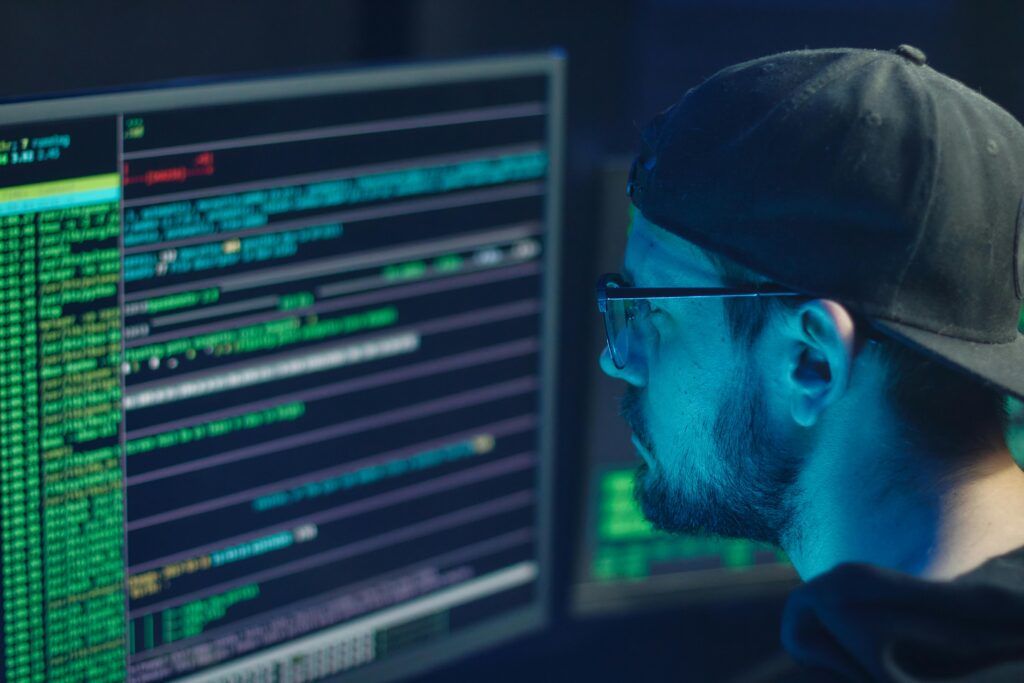Cybersecurity is a critical concern for organizations and individuals alike. With the increasing sophistication of cyber threats, the ability to monitor and detect these threats in real time has become essential. Real-time threat detection allows for immediate response, minimizing potential damage and ensuring the integrity of systems and data. This article will explore the various methods and tools available for real-time cyber threat monitoring and detection, providing a comprehensive guide to enhancing your cybersecurity posture.

Cyber Threats
What Are Cyber Threats?
Cyber threats refer to malicious activities that aim to damage, disrupt, or gain unauthorized access to computer systems, networks, or data. These threats can come in various forms, including malware, phishing attacks, ransomware, and denial-of-service (DoS) attacks. Understanding the nature of these threats is the first step in effectively monitoring and detecting them.
Types of Cyber Threats
- Malware: Malicious software designed to infiltrate and damage systems.
- Phishing: Fraudulent attempts to obtain sensitive information by disguising as a trustworthy entity.
- Ransomware: A type of malware that encrypts data and demands payment for its release.
- Denial-of-Service (DoS) Attacks: Attempts to make a system or network unavailable to its intended users.
- Insider Threats: Threats originating from within the organization, often from employees or contractors.
The Importance of Real-Time Threat Detection
Why Real-Time Detection Matters
Real-time threat detection is crucial because it allows for immediate action to be taken when a threat is identified. This minimizes the potential damage and reduces the time an attacker has to exploit vulnerabilities. Real-time detection also helps in identifying patterns and trends, which can be used to strengthen overall cybersecurity measures.
The Consequences of Delayed Detection
Delayed detection of cyber threats can lead to significant financial losses, reputational damage, and legal consequences. The longer a threat goes undetected, the more damage it can cause. Real-time detection helps mitigate these risks by providing timely alerts and enabling swift response.
Methods for Real-Time Cyber Threat Monitoring
Network Traffic Analysis
Network traffic analysis involves monitoring and analyzing the data flowing through a network to identify suspicious activity. This method can detect anomalies that may indicate a cyber threat, such as unusual data transfers or unauthorized access attempts.
Tools for Network Traffic Analysis
- Wireshark: A network protocol analyzer that captures and interacts with network traffic.
- SolarWinds Network Performance Monitor: A tool that provides real-time network monitoring and analysis.
- PRTG Network Monitor: A comprehensive network monitoring tool that offers real-time alerts and reports.
Endpoint Detection and Response (EDR)
Endpoint Detection and Response (EDR) focuses on monitoring and securing endpoints, such as desktops, laptops, and mobile devices. EDR solutions provide real-time visibility into endpoint activities and can detect and respond to threats at the device level.
Key Features of EDR Solutions
- Real-Time Monitoring: Continuous monitoring of endpoint activities.
- Threat Detection: Identification of malicious activities and potential threats.
- Incident Response: Automated or manual response to detected threats.
Security Information and Event Management (SIEM)
Security Information and Event Management (SIEM) systems collect and analyze data from various sources to provide a comprehensive view of an organization’s security posture. SIEM solutions can detect threats in real-time by correlating data from multiple sources and identifying patterns indicative of malicious activity.
Popular SIEM Solutions
- Splunk: A powerful SIEM tool that offers real-time monitoring and advanced analytics.
- IBM QRadar: A comprehensive SIEM solution that provides real-time threat detection and response.
- LogRhythm: A SIEM platform that offers real-time visibility and automated threat detection.
Intrusion Detection and Prevention Systems (IDPS)
Intrusion Detection and Prevention Systems (IDPS) are designed to detect and prevent unauthorized access to network resources. These systems monitor network traffic for signs of malicious activity and can take automated actions to block or mitigate threats.
Types of IDPS
- Network-Based IDPS: Monitors network traffic for signs of intrusion.
- Host-Based IDPS: Monitors activities on individual devices for signs of intrusion.
Behavioral Analysis
Behavioral analysis involves monitoring user and system behavior to identify deviations from normal patterns. This method can detect insider threats and advanced persistent threats (APTs) that may not be identified by traditional signature-based detection methods.
Techniques for Behavioral Analysis
- User and Entity Behavior Analytics (UEBA): Analyzes user behavior to detect anomalies.
- Machine Learning Algorithms: Uses machine learning to identify patterns and detect deviations.
Implementing Real-Time Threat Detection
Developing a Comprehensive Cybersecurity Strategy
A comprehensive cybersecurity strategy is essential for effective real-time threat detection. This strategy should include the following components:
- Risk Assessment: Identify and assess potential risks to your organization.
- Threat Intelligence: Gather and analyze information about potential threats.
- Incident Response Plan: Develop a plan for responding to detected threats.
- Continuous Monitoring: Implement continuous monitoring to detect threats in real-time.
Integrating Threat Detection Tools
Integrating various threat detection tools can provide a more comprehensive view of your organization’s security posture. This integration allows for the correlation of data from multiple sources, improving the accuracy and effectiveness of threat detection.
Best Practices for Integration
- Centralized Management: Use a centralized platform to manage and monitor all threat detection tools.
- Data Correlation: Correlate data from multiple sources to identify patterns and trends.
- Automated Response: Implement automated response mechanisms to quickly mitigate detected threats.
Training and Awareness
Training and awareness are critical components of a successful real-time threat detection strategy. Employees should be trained to recognize potential threats and understand the importance of reporting suspicious activities.
Key Training Topics
- Phishing Awareness: Educate employees on how to recognize and avoid phishing attacks.
- Password Security: Teach best practices for creating and managing secure passwords.
- Incident Reporting: Encourage employees to report suspicious activities promptly.
Challenges in Real-Time Threat Detection
Complexity of Cyber Threats
The complexity and sophistication of cyber threats continue to evolve, making real-time detection more challenging. Attackers are constantly developing new methods to bypass security measures, requiring organizations to stay vigilant and adapt their strategies accordingly.
Volume of Data
The sheer volume of data generated by networks and systems can make real-time threat detection difficult. Organizations must implement efficient data processing and analysis techniques to manage this data effectively.
False Positives
False positives can be a significant challenge in real-time threat detection. These are alerts that incorrectly identify benign activities as threats, leading to unnecessary investigations and potential disruptions.
Mitigating False Positives
- Fine-Tuning Detection Rules: Regularly update and fine-tune detection rules to reduce false positives.
- Contextual Analysis: Use contextual analysis to differentiate between legitimate and malicious activities.
- Machine Learning: Implement machine learning algorithms to improve the accuracy of threat detection.
Future Trends in Real-Time Threat Detection
Artificial Intelligence and Machine Learning
Artificial intelligence (AI) and machine learning (ML) are playing an increasingly important role in real-time threat detection. These technologies can analyze vast amounts of data quickly and identify patterns that may indicate a threat.
Benefits of AI and ML in Threat Detection
- Improved Accuracy: AI and ML can improve the accuracy of threat detection by identifying subtle patterns.
- Automated Response: These technologies can enable automated response mechanisms, reducing the time to mitigate threats.
- Adaptive Learning: AI and ML systems can adapt to new threats, improving their effectiveness over time.
Cloud-Based Threat Detection
As more organizations move their operations to the cloud, cloud-based threat detection solutions are becoming increasingly important. These solutions offer real-time monitoring and detection capabilities tailored to cloud environments.
Advantages of Cloud-Based Threat Detection
- Scalability: Cloud-based solutions can scale to meet the needs of growing organizations.
- Flexibility: These solutions offer flexibility in terms of deployment and management.
- Integration: Cloud-based threat detection tools can easily integrate with other cloud services.
Zero Trust Architecture
Zero Trust Architecture (ZTA) is a security model that assumes no user or device should be trusted by default, even if they are within the network perimeter. This approach requires continuous verification of user and device identities, enhancing real-time threat detection.
Key Principles of Zero Trust Architecture
- Verify Explicitly: Always verify the identity of users and devices before granting access.
- Least Privilege: Grant users and devices the minimum level of access necessary to perform their tasks.
- Assume Breach: Assume that a breach has occurred or will occur and implement measures to detect and respond to threats in real-time.
Conclusion
Real-time cyber threat monitoring and detection are essential components of a robust cybersecurity strategy. By understanding the nature of cyber threats and implementing effective detection methods, organizations can protect their systems and data from malicious activities. The integration of advanced technologies such as AI, ML, and cloud-based solutions, along with the adoption of Zero Trust Architecture, will further enhance the ability to detect and respond to threats in real-time. Continuous training and awareness, along with a comprehensive cybersecurity strategy, are key to maintaining a strong defense against evolving cyber threats.
FAQs
What is real-time threat detection?
Real-time threat detection refers to the process of identifying and responding to cyber threats as they occur, minimizing potential damage and ensuring the integrity of systems and data.
Why is real-time threat detection important?
Real-time threat detection is important because it allows for immediate action to be taken when a threat is identified, reducing the time an attacker has to exploit vulnerabilities and minimizing potential damage.
What are some common methods for real-time threat detection?
Common methods for real-time threat detection include network traffic analysis, endpoint detection and response (EDR), security information and event management (SIEM), intrusion detection and prevention systems (IDPS), and behavioral analysis.
How can organizations improve their real-time threat detection capabilities?
Organizations can improve their real-time threat detection capabilities by developing a comprehensive cybersecurity strategy, integrating various threat detection tools, and providing continuous training and awareness to employees.
What are the challenges in real-time threat detection?
Challenges in real-time threat detection include the complexity and sophistication of cyber threats, the volume of data generated by networks and systems, and the occurrence of false positives.
What are some future trends in real-time threat detection?
Future trends in real-time threat detection include the increased use of artificial intelligence (AI) and machine learning (ML), the adoption of cloud-based threat detection solutions, and the implementation of Zero Trust Architecture (ZTA).

